Articulation refers to how we make speech sounds using our articulators (mouth, lips, and tongue). For example, we need to be able to say the /l/ sound in order to say “lunch” instead of “wunch” or “yunch.” (ASHA). There are so many different articulation therapy approaches, so how do we decide which one is most appropriate?
By age 5, most children can produce 90% of consonants correctly (Source: McLeod and Crowe, 2018).
Consonant sounds are typically mastered at the following ages:
| Age 2 | /p/ |
| Age 3 | /b, m, d, n, h, t, k, g, w, ng, f, y/ |
| Age 4 | /l, j, ch, s, v, sh, z/ |
| Age 5 | /r, zh/, voiced /th/ |
| Age 6 | voiceless /th/ |
Source: McLeod and Crowe, 2018
For a free download of the above chart and information, check out my free resource library. I have an instant download that you can print and have ready to share with parents as needed.
Speech Sound Development and Concerns
“My child still can’t say _____, do they need speech or should we just wait and see?”
I get asked a variation of this question all the time! In fact, just tonight my husband got a text from an old work buddy saying, “Hey, can you ask your wife about this? My wife is worried about our daughter.” Of course, I don’t mind because I love what I do and sharing what I know! As moms (or dads, or grandparents/caregivers/guardians/teachers) the more we know, the sooner we can take action when needed. I usually recommend seeking a referral to a certified SLP for a full evaluation anytime a parent has concerns about their child’s speech.

So, what will therapy look like after an evaluation is completed and it is determined that a child has a speech sound disorder? How is this disorder going to be treated?
As a professional, how do you determine what approach(es) to use in therapy?
What are the Different Therapy Approaches for Articulation?
“Historically, treatments that focus on motor production of speech sounds are called articulation approaches; treatments that focus on the linguistic aspects of speech production are called phonological/language-based approaches.” (ASHA)
Articulation therapy approaches – the clinician selects target sounds. These approaches are used when the errors are motor-based.
Phonological/Language-based approaches target a group of sounds with similar patterns selected to help the child internalize and generalize phonological rules to other sounds within that pattern.

Types of Treatment Strategies
Vertical treatment strategies are intense and focus on 1-2 target sounds until a mastery level (typically conversation level) is met. Then the clinician moves on to the next target sound.
Horizontal treatment strategies are less intense and target a few sounds at a time. The child is then exposed to more sounds.
Cycles treatment strategies target sound patterns for a set amount of time (not based on mastery) and then the clinician moves on to the next target and cycles through all targets again as needed.
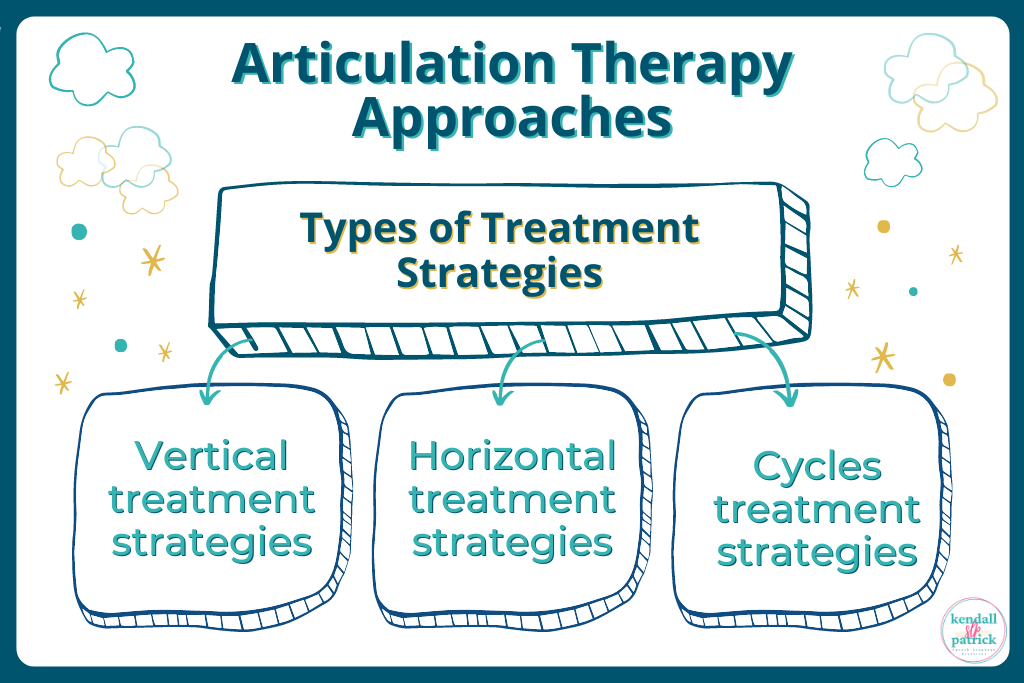
What is Traditional Articulation Therapy?
The Traditional Approach to articulation therapy focuses on working on one sound at a time, progressing from isolation to conversation, and was developed by Van Riper in 1978.
Traditional Articulation Therapy Approach
The traditional approach is a commonly used approach in speech therapy. I use it quite often with a lot of my students. This method focuses on one sound at a time. You practice the sounds at each level (isolation, word, phrase, sentence, etc.) until the child reaches mastery and then move on to the next. I use this with my students with just a couple of error sounds, but typically my kiddos working on multiple phonological processes don’t make quick progress with this method. So I don’t really find this approach to be the most effective in these cases.
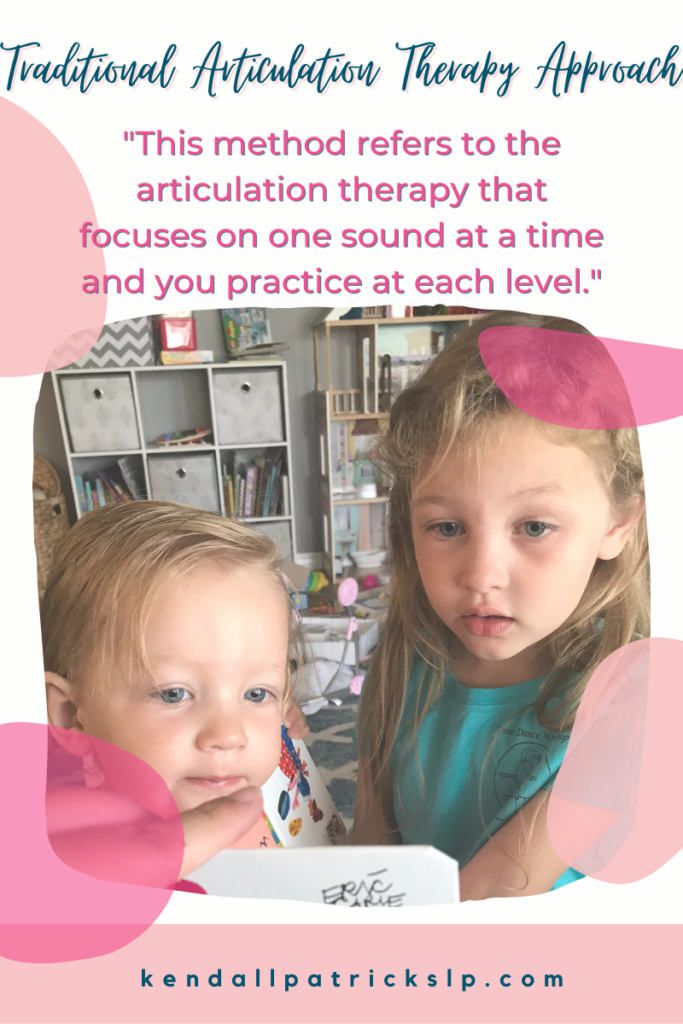
What are the Minimal and Maximal Pairs Therapy Approaches?
The Minimal Pairs Approach focuses on pairing words that differ in only one phonological element (one containing the target) (e.g., “spot” and “pot”). Minimal pairs was developed by Blache, Parsons, Humphreys, and Weiner in 1981.
The Maximal Pairs Approach focuses on pairing words with contrasting sounds that differ in multiple ways (voice, place, manner) and was developed by Gierut in 1989.
An empty set strategy is similar to maximal pairs, however, this approach uses word pairs with contrasting sounds, both using unknown sounds.

Using Minimal Pairs in Therapy
The Minimal Pairs Approach is highly effective in treating phonological processes as well and is great to pair with other phonemic awareness tasks.
Examples for targeting cluster reduction (s-blends):
- stick – sick; stack – sack (deleting the second consonant in the blend)
- smash – mash; spill – pill (deleting the /s/ in the blend)
Using Maximal Pairs in Therapy
Examples:
- /ch, l/ chip – lip; chick – lick
- /k, r/ camp – lamp; kite – light
Place, Manner and Voicing Chart for English Consonants (Roth & Worthington, 2018)
Here’s what a therapy session might look like for both:
- Introduce the targets that will be used in the therapy session by labeling the pictures.
- Spread out all of the pictures and have the child point to or pick up the picture that matches the word you say.
- Then have the child name a picture for the clinician to pick up (pick up the one that they say, even if you know they meant a different word) and provide cues as needed to help determine which word they “meant” to say.
- Bingo and go fish games can be a fun way to use this approach as the child becomes more comfortable with the targets
What is the Cycles Approach?
The Cycles Approach targets each phonological process for a short, fixed amount of time and cycling through other phonological processes, ideal for children with a lot of error patterns, and was developed by Barbara Hodson in 1983 and 1991.
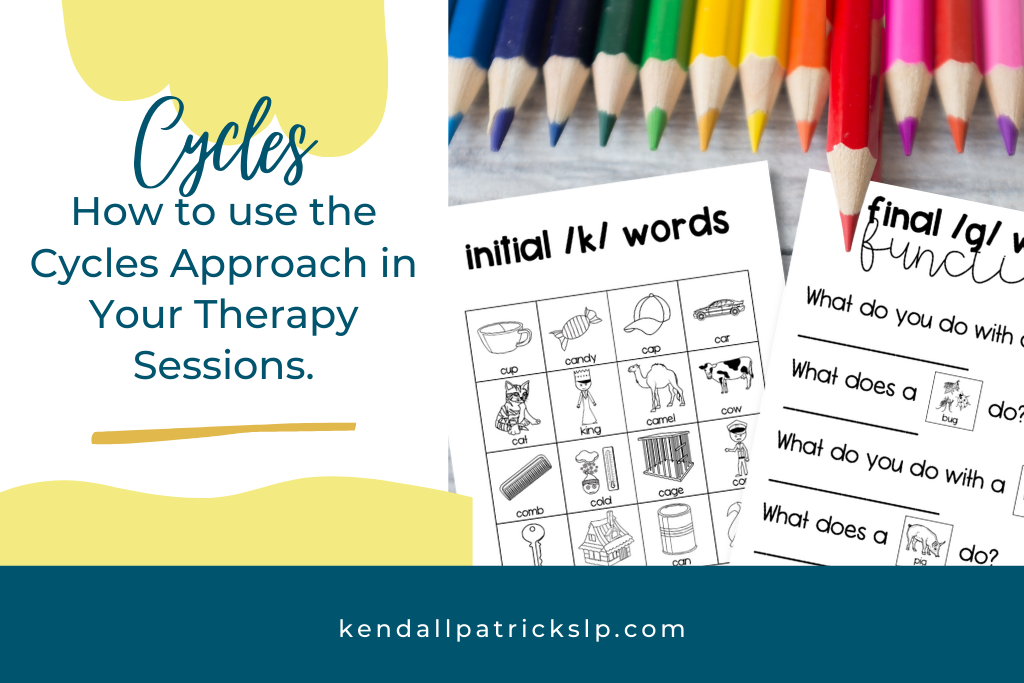
How to Implement the Cycles Approach
The Cycles Approach, developed by Barbara Hodson, is an approach in which you target each phonological process for a short, fixed amount of time and cycle through other phonological processes. This approach is ideal for children with a lot of error patterns.
Here is what it might look like:
Week 1: final consonants
Week 2: final /k/
Week 3: initial /k/
Week 4-10: initial /s/ blends
Week 11-13: final /s/ blends
Week 14: initial /l/
Week 15: initial /r/
It can be difficult to move on to the next cycle when you know they haven’t reached mastery, but it is so worth it! You will be amazed at how much progress they will make just after addressing /s/ blends. While it may seem too complex to target those sounds early on, research actually supports targeting the more difficult sounds first. Once they have mastered (or even just made some progress) on those blends, you will see progress in earlier developing sounds as well. I have found that using this approach I don’t even have to target /s/ and /z/ individually as they come along on their own!
Here is what a single session working on an /s/ blend target might look like:
- Auditory Bombardment: SLP orally presents target words (e.g., stew, step, stick, stop, stone) and the student just listens (they do not participate in saying the words).
- Introduce new sounds as “friends.” Example: This is Mr. S and Mr. T. Mr. S was feeling very lonely and wanted a friend, so along came Mr. T. They go on a walk together, but it is very important they stay together!
- Practice sounds with tactile cues: I like to have the student move their finger along the table as they say the /s/ sound and tap as they say the /t/ (as seen below).
- Practice target words (stick to the simpler, 1 syllable words if needed) and repeat with lots and lots of trials.
- Model in phrases and sentences and (if appropriate) have the student repeat the modeled phrases/sentences.
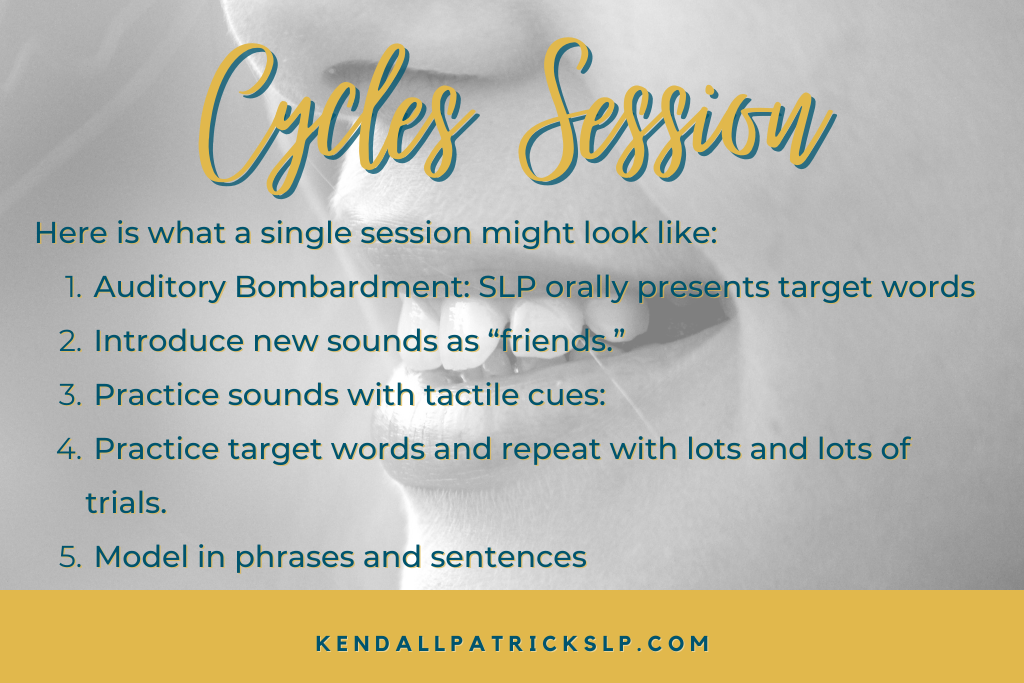
Complexity Approach
The Complexity Approach introduces more complex sounds first in order to help generalize corrections to untreated sounds as well.
This might look like: targeting /s/ blends in therapy first, and /s, z/ errors are also corrected without ever formally addressing those sounds in isolation in therapy.
For more information on treating /s/ blends in speech therapy, check out my blog post here.
Speech Therapy Techniques for Articulation
Visual & Verbal Cues
- Modeling
- Pointing to/drawing attention to your mouth/articulators
- Using a mirror so they can see their own articulators
- Auditory Bombardment
- Amplification
Auditory Cues
- Amplification
- Auditory Feedback
Tactile Cues
- Tools used in the mouth (e.g., tongue depressor, lollipop, Speech Buddy Tool)
- Gestural cues
Articulation Therapy Techniques pdf
Click here for a free download that outlines articulation therapy techniques to keep these tips close by for whenever you need them!
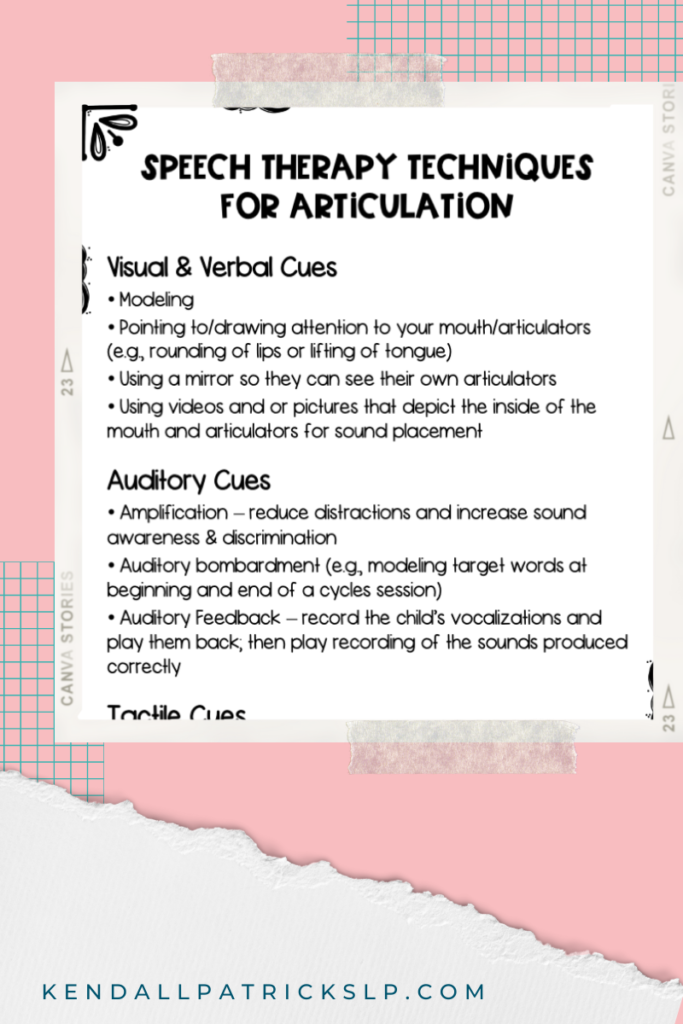
Articulation Therapy Approaches and Service Delivery
It is important to take into account the various service delivery models you will be utilizing for your caseload. I usually have a lot of groups that are seen twice a week for 30 minutes each. This makes up most of my schedule. But, I also see kids in a “5-minute kid” model for articulation daily. I have some groups that come 3 or 4 days because they have higher needs or the need for more frequent services. Some students come to speech just once a week (e.g., in a fluency or social skills group) and I also push-in to our full-time ESE classroom.
Sample schedule in freebie library
One of my strategies for making this process of including all the different models a little easier is scheduling my students in the full-time room (who typically have more services) first so I can work with the teacher and make our schedules together (she typically sees pull-out students as well as her students who she has full-time). I block out their times first. Then I put in my groups seen 3-4 times a week (e.g., students who have apraxia or severe phonological delays) so that they have the same time all week. Then I schedule everyone else usually leaving the once-a-weekers for last because they are a little bit easier to fit into any open slots.
For more information about different service delivery models, check out this article from ASHA:
School-Based Service Delivery Models – ASHA
“5 Minute Kid” Therapy Model
In this delivery model, students are seen within/near their classrooms for 5-10 minutes daily for quick, intense articulation sessions. This is instead of in longer sessions in a small group 1-2 days/week. The benefits of this model are: the therapy is provided one-on-one, you get to see them more often, they miss less class time, and there are less distractions (e.g., other group members, treasure box, games, etc.).
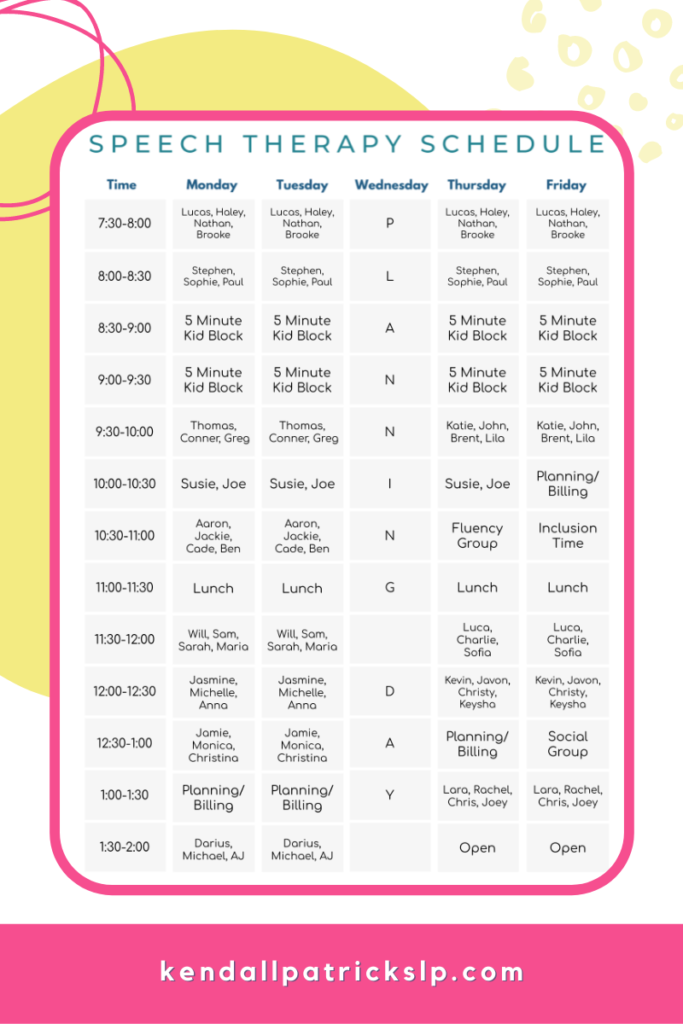
Need for More Frequent, Shorter Sessions
In some cases (e.g., Childhood Apraxia of Speech diagnosis or severe phonological impairments), shorter more frequent sessions are needed. Research supports 3-5 days a week of intensive services for these cases.
The reality is, scheduling different service delivery models in the school setting is not always easy (and in some cases, nearly impossible). But it is critical to remember that not one size fits all. So your service delivery model should not look exactly the same for every single student on your caseload.
For more tips on how I schedule my various service delivery models, check out my blog post on SLP scheduling here.
Additional Information on Various Articulation Therapy Approaches:
How to Choose a Therapy Approach for Speech Sounds from Speech and Language Kids
Best Practice for Articulation from Super Power Speech
Articulation Therapy Guide from Speech Therapy Talk Services, LLC
Don’t forget to check out my freebie library, access it here:
I hope you found the information about articulation approaches and techniques helpful and can use this information to guide your own journey with your child or your SLP journey. Please leave a comment or shoot me an email if you want to share some of your favorite articulation therapy approaches.

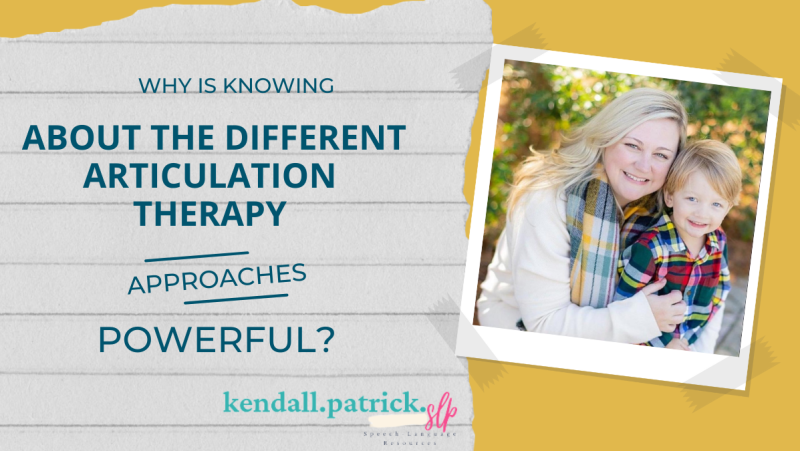

2 Responses